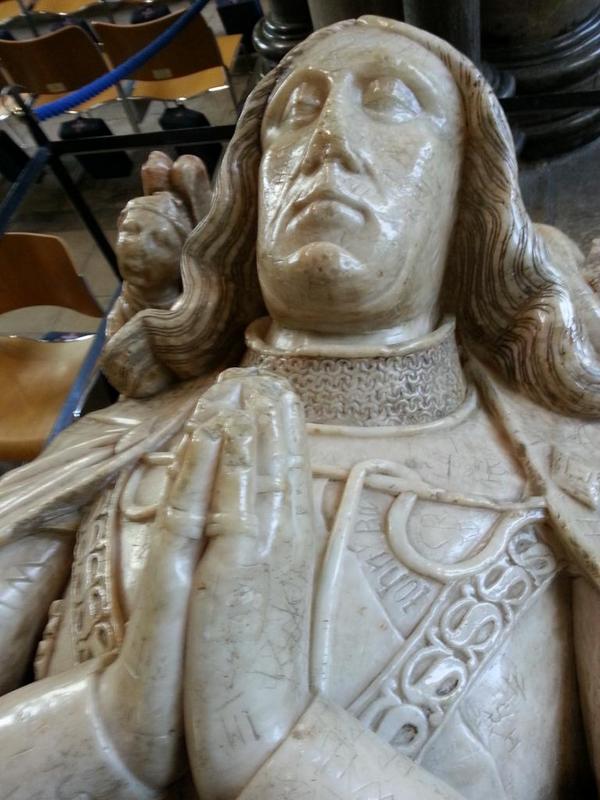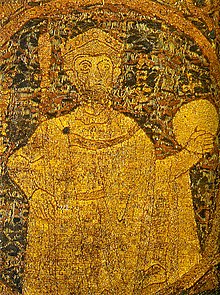August 5th was the feast day of St Oswald, the seventh century Northumbrian King and Martyr. There is a good account of him from
Wikipedia at
Oswald of Northumbria. The Orthodoxwiki site also has an account at Oswald of Northumbria
Over two days this past week I was able thanks to the Internet to attend a splendid online conference about his medieval cult. Entitled Liturgy, Literature and History: Oswald of Northumbria and the Cult of Saints in the High Middle Ages this explored a range of aspects and places associated with his commemoration.
St Oswald as depicted in a thirteenth century manuscript
Image : Wikipedia
Coming as I do from Yorkshire I instinctively associate St Iswsld with Northumbria and with Befe’s account of his life and reign. However St Oswald had, as I have learned over the years, a much wider cultus than his homeland. In addition to his head being enshrined at Durham with St Cuthbert - and hence the standard image of him holding the head of St Oswald - some of his relics travelled via Bardney Abbey in Lincolnshire to St Oswald’s Priory at Gloucester, and the miraculously incorrupt right arm was “removed” - at, or so the Peterborough chronicler insisted, St Oswald’s wish - from Bamburgh to Peterborough by a monk of that monastery in the mid-eleventh century. Thereafter it was kept in the chspel in the south transept of the rebuilt Norman abbey church until the dissolution. This slightly unusual location as opposed to the high altar may reflect its original location in relation to the preceding Anglo-Saxon church. The nature of this now lost reliquary - was it a simulacrum of an arm raised in blessing - was raised by two speakers.
Others concentrated on how the monks at Peterborough developed the Office for the Feast and Octave of St Oswald, and also how that was developed on the Continent. In England I suspect the extent to which his cult spread through Flanders to southern Germany, Switzerland, Austria and southern Bohemia with English missionaries in the later seventh and eighth centuries and, as another talk highlighted, to Lower Saxony in the twelfth century, is not widely appreciated. There are still many churches in those regions as well as the Swiss canton of Zuh under this patronage. Thus the Benedictine community at Weingarten near the Bodensee adopted him as co-patron alongside St Martin and, like the monks at Peterborough, developed and expanded his liturgical celebration. Elsewhere it spread to Sweden and its dependency of Finland with missionaries in the twelfth century.

An illuminated initial showing the martyrdom and mutilation of St Oswald - Darmstadt. Universitats- und Landsbibliothek, HS 2766, 4r - and the Hildesheim Head Reliquary of St Oswald.
Image: thijsporck.com
The famous Hildesheim reliquary - apparently for a skull relic of the saint ( there were several
of these ) was considered in relation to the gifts to the cathedral there and at Brunswick
( Braunsweig ) associated with Matilda of England, daughter of King Henry II and Queen
Eleanor of Aquitaine, and her husband Duke Henry the Lion, and their son Emperor Otto IV.
St Oswald as a royal saint in England was considered by Professor Nicholas Vincent in s fascination paper, which showed how, after SS Edward the Cinfesdor and Edmund the Martyr, Oswald occupied third place for a long period in the pantheon of regal exemplar saints. His points about the importance of the Augustinian priory of St Oswald at Nostell, very much in my home area, and the patronage bestowed upon it by King Henry I and its links to the church at Bamburgh and to the Augustinian cathedral priories at Carlisle and St Andrews was of particular interest to me.
Four Kings from Matthew Paris’ Epitome of Chronicles of the mid-thirteenth century.
Top left King Uther Pendragon and below his son King Arthur, top right King St Arthelbert of Kent and below King St Oswald
Image:Wikipedia
Apart from the wooden cross he set up at Heavenfield and shown in his illustration by Matthew Paris St Oswald’s other attribute is a raven.
This aspect of his story appears to be better known in Germany and the penultimate lecture was about a charming later medieval version of the story from Munich about St Oswald and his pet talking raven. In the first part of the Munich Oswald, in the initial quest for a bride for the King, the raven is his messenger, and a rather Jeeves like servant to a Woosterish Oswald. The raven is not above describing the King as a “clot” and after going on a mission refuses on his return to recount the reply until he has been fed and had a night’s sleep…The raven also insists on getting the royal goldsmith to ornament his feathers and make him a crown so people will admire him rather than try to kill him. This canny bird’s closest parallel inconporary English literature that I can think of is the eagle who carries Chaucer heavenwards in The House of Fame.
The whole story of this courtship is fabulous in both senses - the historical reality appears to be that King Oswald married Kyneburga, daughter of King Cynegils of Wessex, at whose baptism, apparently at Dorchester on Thames by St Birinus St Oswald was his father-in-law’s sponsor.
I am very grateful to the organisers of the conference and to the technology which made it possible for me to attend.
The original plan had been for the conference to include a celebration of the Peterborough liturgy for St Oswald on his feast day in the cathedral. That had to be deferred, but it is hoped to be able to do that in 2022.
It is very good to see that Oswaldian studies are flourishing in several branches of academic research, and long May that continue.
St Oswald, pray for us











